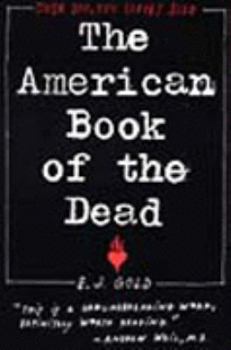The American Book of the Dead
Select Format
Select Condition 
Book Overview
With over 120,000 copies sold, this unique contemporary work brings the timeless Tibetan Bardo teaching into current American culture and language, with 49 days of readings for someone who has died or... This description may be from another edition of this product.
Format:Paperback
Language:English
ISBN:0062513109
ISBN13:9780062513106
Release Date:January 1995
Publisher:HarperOne
Length:175 Pages
Weight:0.35 lbs.
Dimensions:0.5" x 5.2" x 7.9"
Customer Reviews
5 ratings
Use it because it works
Published by Thriftbooks.com User , 15 years ago
There is really nothing better you can do than read this book, when you are in a state of mourning or realize that you will be soon. Here I was able to find a way to deal with deep grief. I have given this book to friends and family in similar situations. It is not something you expect thanks for. You just know it will help more than anything else you could do.
Use of the Handbook
Published by Thriftbooks.com User , 17 years ago
I was first introduced to this book about 35 years ago when my mother was dying. I found it difficult to relate this book to my mother's experience. Through the years as I used this book for myself and subsequently for others I discovered that the reading aloud of these texts was significantly different than reading silently and that the more freedom (nonjudgmental thinking) I allowed myself in working with this book as a guide or a handbook the more I received in terms of understanding and healing.
A Useful Guidebook for Work with those in Crisis
Published by Thriftbooks.com User , 17 years ago
I do a lot of work with the critically ill and dying and even though I appreciate the concerns of the reviewers here, many of them seem to hold a theoretical view of this text. I, however, use it as a guidebook to help in critical, high stress, transitional situations. It aligns, of course, with the Tibetan Buddhist Bardo teachings but it presents them in a context that is culturally accessible and, dare I say it, sometimes humorous. It offers the teachings to the westerner without a religious context and opens the way of equanimity. It gives an excellent presentation of how to prepare the room during passage, make contact with the "patient" or voyager, give an effective reading, and recognize the stages of physical death. It provides a way for families and those who are bereaved to participate in a more conscious passage for their loved one because it is designed to help them remember and align to their own spiritual practice(s). In the resonance of the various chambers with different psychological states, it is also a workbook for those in psychological crisis. All very practical stuff. I think that you will find that this is a book which can only be understood in the context as used to help others, and in this way to gain some measure of understanding yourself.
ZHI-TRO GOMPA RANGDROL BARDO THODAL
Published by Thriftbooks.com User , 21 years ago
DISCLAIMER: This reader, being feeble and infirm of bodymind, is woefully ignorant of both Sufism and the various New-Age paths and practices (and E.J. Gold for that matter).But upon encountering the ABD some years ago, it seemed an imaginative, clear and well-rendered paraphrase of the Zhi-Tro teachings (Padmasambhava's Self-Liberation teachings), much revered in the Tibetan Nyingma tradition.Note that this work is not represented as a translation or as an "alternative" to anything, and is thus not bound by language. It's not prose; it's a manual. It's in the application, more than in the casual reading, that one finds the spirit if not the letter of the teaching. Who knows? Maybe it's terma (revealed treasure). I've seen it used by Nyingma ngakpa yogis, side by side with chants and mantras during bardo prayers/sadhanas.Homage to Teachers; to lineage masters and hidden yogis -- may they bless us in the Three Times and between.om ah hum hri
A translated and modernised error is still an error....
Published by Thriftbooks.com User , 21 years ago
Having been familiar with the Evans-Wentz translation of the Tibetan Book of the Dead for many years I decided to give this "Americanised" version a try. I was aware that much of the rigid detail and ritual of the original was probably unique to Tibetan culture and I wanted to see how the author dealt with it. Now that I've read this version I'm somewhat conflicted as to my opinion of it. The basic ritual and structure of the original is preserved, but with modern terminology and images substituted. This is an improvement- sort of. However, I'd rather cut through the accrued ritual and superficial detail and get down to the core truths- not just make the dross more modern and "hip." There is truth here, but you still have to cut away the obscuring distortions. First of all, the existance that is being described is both beyond time and beyond conventional aristotlian sequential logic. Think about it, do you really believe memorising this sequence of events- or reading them aloud to the dead on a rigid timetable- is of any real value? The afterlife doesn't run on a bus schedule folks- to use my own little modernism here.What is truly important are the deep truths and values that you have welded to your spirit before you cross over- memorising spiritual "cheat sheets" and last minute "cramming" just isn't going to cut it.... Though, the state of mind immediately before one's passing is of importance. It isn't the overriding determinate, however.Still, what is being described here as the "macrodimensions" do exist. I've always been sensitive to them, and you probably have too. And, yes, we do project much of what we are superficially familiar with upon them- as have those who have passed that way before us.Worth reading, but do so with a discriminating mind- and cross check it with your "inner guide."




